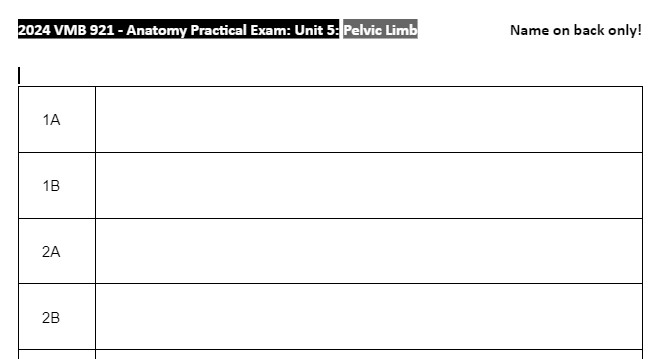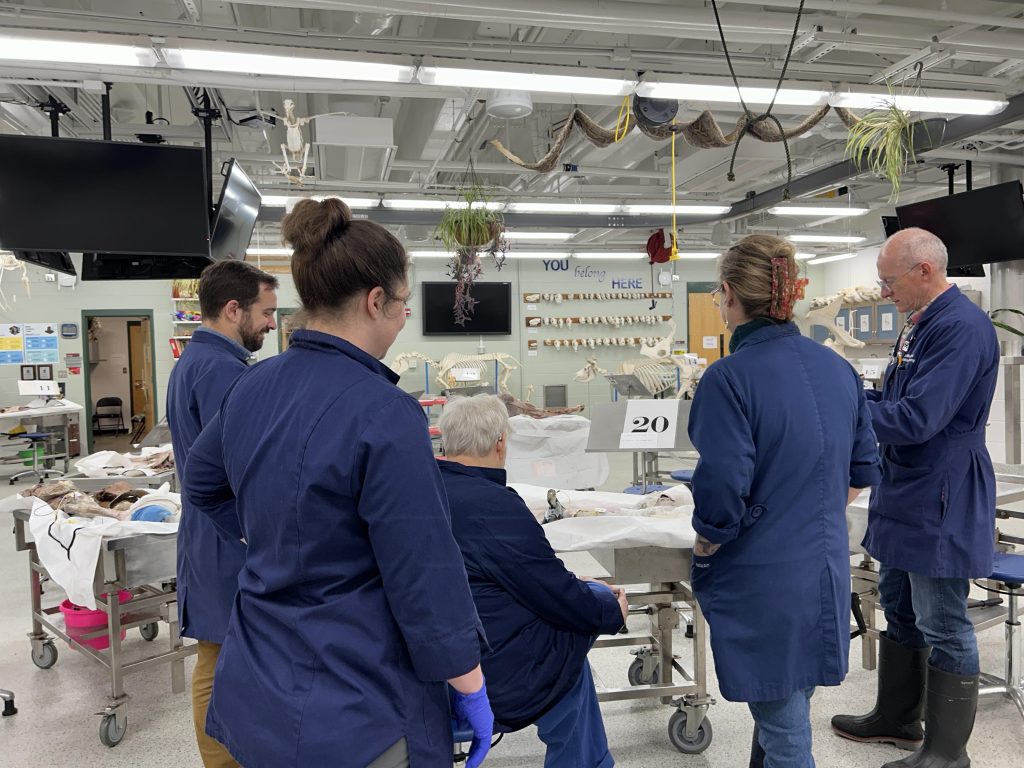Tips for your first practical exam
Logistics and tips for your first Anatomy Practical Exam
Study Recommendations
- Study using all cadavers – exam questions are set up using cadavers, bones, articulated skeletons, plastinated specimens, and wet specimens.
- Pay attention to species differences.
- Interweave the studying of the different structures- bones, muscles, lymph nodes, ligaments, joints. The questions will not be set up in a specific order or in sections.
- Take good care of all the cadavers- they will still be used regardless of how dried out they may have become. Treat them with reverence.
- Take any mock practical exams organized by your class.
- Check terms lists for testable material; many diagrams list structures beyond the scope of this course.
- The practice exam question in this guide are taken from real exam stations. Use them to see how questions are worded and set up.
Logistics
- The lab closes at 7:30am the morning of the exam. It is otherwise available for your studying 24/7 most days.
- Written answer sheet and clipboard are provided for you.
- Bring your pencil(s) (with eraser!) or ball point pen only. No felt tip pens.
- Be sure your ‘final’ answer is clear. Multiple answers are not acceptable.
- Specimens usually cannot be touched. Occasionally, a bone specimen can be picked up if the question card indicates this.
- Questions cannot be asked during exam – only if you feel the question has been disrupted (ie. the pin or tape has fallen).
- The back page is a space for you to record your questions/confusions/concerns.
Exam Layout
- 30 stations to accommodate half the class at a time.
- The room will be laid out with stations in an inner and outer circle.
- Approximately 1 hour to complete the exam in whatever order you prefer. A countdown timer will be displayed.
- Respect your peers and do not crowd a station.
- Keep your answer sheet close while stepping forward to view the question.
- Step out of the way to write your answer.
Answering Questions
Before answering each question:
- Take a deep breath!
- ORIENT YOURSELF!
- What species?
- Right or Left limb?
- Medial or Lateral side?
- Which part of the limb am I looking at?
- Read the question twice! Be sure to know what the question is asking!
- A 2-step question may ask: Identify the _____ of the pinned muscle.”
- action
- proximal/distal attachment
- Giving the muscle name would be incorrect in this example.
- A 2-step question may ask: Identify the _____ of the pinned muscle.”
- We are NEVER trying to create a trick question. We aim to give the best example possible of each structure on the exam.
- Believe in what you know! – Students commonly erase the correct answer after second guessing themselves.
- Remember to put muscle/artery/vein/nerve/lymph node etc. at the end of your answers (can abbreviate – m/a/v/n/ln)
- If the answer requires the side or joint, we will specify that in the question.
- Give the most specific answer applicable for full credit. Partial credit is given at grader digression.
- Instead of “triceps brachii m.”, give “long head of triceps brachii m.”
Gradescope
We use a program called Gradescope to help us grade practical exams more efficiently, which gets your exam results back quicker. The program uses AI to help group similar answers together – the AI does not do any aspect of the grading. Your instructors decide how much credit each group of answers receives. Your instructors are very intentional about checking the AI’s grouping and making sure answers are grouped into the appropriate credit levels.
A few things that help us:
- Spelling and handwriting need to be legible. Spelling isn’t specifically graded. BUT – watch out for similar anatomical words (ie: cornual – horn vs. corneal – eye)
- Write your answer firmly, it helps the AI pick up answers.
- Keep answer within the answer box.

Use the test to take the test!
- We will specify “Identify the” muscle, artery, vein, nerve or structure.
- “Structure” is a catch-all term for “none of those other things”. This could include lymph nodes, glands, ligaments, external features, etc.
- If the question asks “Identify the lymph structure”, don’t answer a muscle/artery/nerve!
- “Identify the bone” would be asking for the name of the entire bone, vs “Identify the bone feature” would be a particular aspect of the bone.
- If you don’t know, GUESS!
- Most anatomical structures are named for their attachments, shape, etc. so you may be able to guess close enough to get partial credit.
How is the exam set up?
Before the exam, the lead instructor of the unit will create a list of structures to be examined.
On the morning of the exam, the instructional team will use the list to set exam stations.
Once all the questions are set, the team reviews the stations as a group in order to evaluate question wording and cadaver setup. Our goal is to find the cadaver that best represents the question being asked, and write a question that eliminates as much ambiguity as possible. We aren’t testing your ability to decipher an exam question, we are testing whether you understand the anatomy.

Most importantly, from your instructors:
